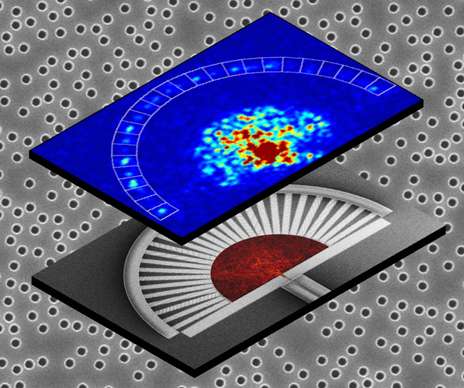Random, scattered, and ultra tiny: A spectrometer for the future

Sometimes a little disorder is precisely what's in order. Taking advantage of the sensitive nature of randomly scattered light, Yale University researchers have developed an ultra-compact, low-cost spectrometer with improved resolution over existing micro models. The innovation represents an advance in "lab-on-a-chip" technology, or the consolidation of laboratory capabilities in miniature, highly portable devices.
"The largest dimension of our spectrometer, which we built on a silicon chip, is about the width of a human hair," said Brandon Redding, a postdoctoral associate in applied physics at Yale and lead author of research published online in the journal Nature Photonics. "It could open up a whole new range of uses, a lot of them outside the lab."
Hui Cao, professor of applied physics and physics at Yale, is principal investigator.
Spectrometers are instruments that measure the different wavelengths (i.e. colors) of light and can be used to identify substances' chemical composition and for other types of materials analysis. They are used in biomedical imaging, defense, telecommunications, and many other fields, as well as in fundamental science research. Tiny spectrometers are desirable both for their extreme portability and because they could be mass-produced at a low cost.
Standard commercial spectrometers range in size from a few inches to a few feet and currently cost thousands of dollars, mainly because resolution typically correlates with the size of the device: The bigger the device, the better the resolution. But this adds to expense and limits versatility.
The Yale researchers worked around this problem by introducing randomly placed holes in the silicon chip to scatter incoming light. Prevented from traveling in a straight line, the light beams bounce from one hole to another, increasing the effective distance they travel to get through the chip. This results in better resolution, despite the tiny scale of the device.
"In our case, resolution scales with the square of the size of the device," Redding said. "We get a much longer path length for our light relative to the size of the device, because the light bounces around many times."
In tests, the researchers showed that their micro spectrometer can detect a change in wavelength of less than one nanometer, roughly matching the capability of macroscopic spectrometers about the size of a hard drive.
While standard tabletop spectrometers still offer significantly greater resolution, the researchers said, the tiny new spectrometer represents an improvement over existing on-chip spectrometers, which have generally required tradeoffs in sensitivity, resolution, or ease of fabrication as they've become smaller.
"We're taking a very different approach," said Redding. "The idea of using disorder and multiple scattering is a fairly unexplored concept. Normally, disorder is something you want to overcome or avoid. In this case, it's what lets us make the device so small."
The paper is titled "Compact spectrometer based on a disordered photonic chip." Co-authors are Seng Fatt Liew and Raktim Sarma, also of Yale.
Journal information: Nature Photonics
Provided by Yale University





















